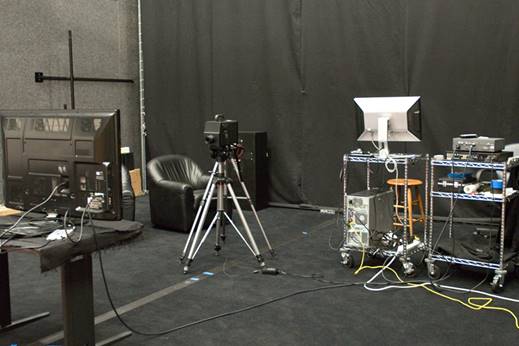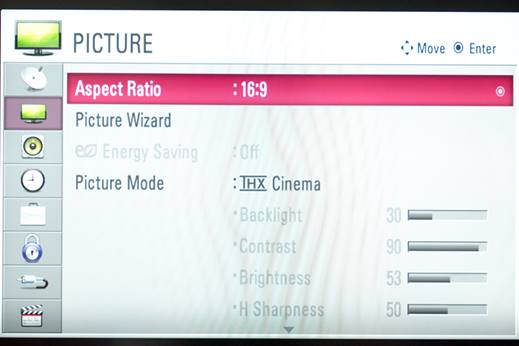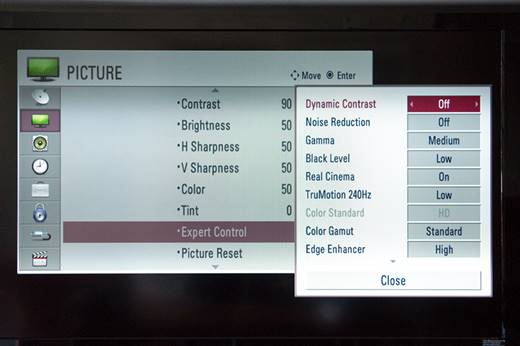THX Certified HDTVs - Useful or Just Marketing?
by Loyd Case on March 6, 2010 12:00 AM EST- Posted in
- Smartphones
- Mobile
In the Lab
All this talk about setting standards and assisting companies develop products that meet those stringent standards is well and good, but what’s involved in the testing process?
THX has both audio and video labs at their San Rafael, California facility. The audio labs include an anechoic chamber, studio space and test equipment. The HDTV test lab consists of two separate labs. One large space can be completely darkened, and is used to test panel uniformity, color tracking, color temperature and other parameters. The main instrument is a Konica-Minolta CS-2000 spectroradiometer, used to measure contrast ratios, color temperature and related specs. Also on tap is a high end digital camera back used to measure panel uniformity.

A panel manufacturer begins with very early samples, often lacking amenities like bezels, in order to start dialing in the electronics. At the beginning, the result may be pretty poor.
![]() Image: color tracking -- bad
Image: color tracking -- bad
Over time, the panel electronics are tweaked, software updates written and all the various pieces are tuned to bring the final result close to that magical linearity.
![]()
The second lab is the subjective test lab. Tests that require visual inspection, like anti-aliasing performance, happen in this lab. While some actual content from film and video sources is viewed as a sort of final sanity check, most of what occurs is visual inspection of test patterns. Some of the testing is more aggressive than publicly available tests. For example, it’s possible that an HDTV panel might pass the publicly available HQV benchmark for anti-aliasing, but fail on the THX test.
The bottom line: there’s a ton of testing and tweaking that goes on before an HDTV receives THX video certification. How does this play in the real world? Let’s take a look at a case study.
Case Study: The LG 55LH90 LCD HDTV
LG makes a number of THX certified HDTV. The current high end of their LCD line is the LG 55LH90. This is a zone-backlit LCD using LED backlighting. In addition to THX certification, the unit offers two “ISF” settings. (ISF is the Imaging Science Foundation, which trains and certifies custom installers for home theater video calibration work.)
LG loaned me a 55LH90 to try out in my living space, so what I’ll be discussing isn’t some unit in an ideal lab, but one in my viewing room. My family room has a large glass patio door on one side, and overhead lighting which isn’t dimmable. It’s a 15’ x 15’ area, with the main seating about 7 feet back from the HDTV.
The LG unit offers a THX setting, which is set to about 130 cd/m2, with zone backlighting enabled. It’s worth discussing the differences between the THX settings and the ISF menu entries.
The THX setting is tuned for film material, though certainly works well on standard HDTV content as well. It’s a “what you see is what you get” setting. In fact, many of the normally tweakable settings are grayed out. You can think of the THX setting as a sort of pre-calibrated setting suitable for relatively light controlled viewing environments.

Note how much the backlighting is dialed down – it’s set to 30%. The THX setting also disables high refresh rate and dynamic contrast ratio settings.
The ISF settings, on the other hand, are there specifically for tweaking by professional calibrators, though users are certainly free to change them as well; these are not hidden under some special factory code.

Interestingly, the 55LH90 also has a simple, but useful, calibration routine built into the menu system. If you don’t like any of the out-of-the-box settings, but don’t want to pay for custom calibration, then you can use the built in tools to perform a good, first level calibration. As with similar tools on the PC, you’re walked through a series of screens which allow you to tweak black levels, brightness and color best suited to your viewing tastes and environment.

The THX mode looks stunning to my eyes -- particularly with movie and episodic TV content. Blu-ray movies, in particular, offer up impressive black levels and terrific detail. I’ve seen a lot of LCD TVs, and have always leaned towards plasmas. No LCD TV has ever really satisfied my viewing tastes – until now. I can safely say that this LG unit is the best LCT HDTV I’ve seen to date. Even viewing angles seem better than past LCDs I’ve viewed – but bear in mind my 15x15 space means no one really sits at steeper off-axis angles.
Since most of our HDTV viewing is in the evening, light control really isn’t an issue. Even during sunny daylight, though, the brightness seems adequate in THX mode. While we do have a large sliding glass door, we never get direct sunlight into the room.
I’ve tweaked settings for other types of material. I’ve been watching the Winter Olympics in high def recently. While THX mode is sufficient, it’s not really enough, and tweaking the settings – including enabling the higher frame rate – makes viewing that type of content more enjoyable. Interestingly, the “Sports” preset was too bright for Olympics, though it did look fine when watching the Super Bowl.
Given my experience, the LG unit gets a definite thumbs up. But my experience with THX mode isn’t mirrored by others. CNET’s test lab found THX mode to be quite blue . That wasn’t reflected in the THX mode I saw, which had no visible blue cast, as an 8200K average color temperature would indicate. That points to potential product quality inconsistencies or perhaps a firmware update on my version.
There is, of course, a price premium, though not as much as you’d suspect. Recent price checks show the LG 55LH90 priced at a around $2,000. That’s not out of line for 55-inch premium HDTVs. Some Samsung and Sony units can cost quite a bit more. So for your $2K, get an excellent LCD HDTV with zone LED backlighting (not edge backlit) and a THX preset that serves quite well for movie watching. On top of that, you can tweak almost every setting to your heart’s content.










30 Comments
View All Comments
Patrick Wolf - Saturday, March 6, 2010 - link
Setting your speakers to "Small" and having an 80Hz crossover is not just a THX recommendation. It's a universally accepted method for achieving proper calibration. The only time you set your speakers to "Large" is if you don't have a subwoofer. The auto-calibration on many AVR's often set this incorrectly.If your speakers do perform well at 50Hz, you can experiment with the crossover, but you need to set your speakers to "Small". However, your Studio 20's for example are actually rated ±2dB from 54Hz-22kHz. So your crossover should at least be 60Hz.
SeanFowler - Saturday, March 6, 2010 - link
I found that adding a subwoofer breathed new life into my Mission speakers, with the Missions set to small even though they're rated down to 40Hz.Just because speakers can handle low frequencies doesn't mean you should let them. My Missions were muddy in the midrange because the bass was swamping them.
Removing that bass from them allows them to do a far better job with the midrange. Result, no muddiness.
jkostans - Sunday, March 7, 2010 - link
THX is a waste of time in consumer products, is doesn't mean anything about quality. The audio and video fields are full of smoke and mirrors. Actual calibrated measurements are the only thing you can trust. 90% of audiophiles are idiots that like to spend money and brag about how good their $10,000 interconnects sound. Subjective results are only as good as the person doing the testing.erple2 - Monday, March 8, 2010 - link
I'd disagree with that. The highly trained ear can hear the difference in quality between the "$10,000 Interconnects", but the reality is that the vast majority of A/V snobs really aren't trained at all.The vast majority of people don't know what really does sound "good". Also, calibration is really only good to the consumer, not to the person doing the testing. In fact, you could easily argue that none of the calibration matters to anyone other than the consumer - if it doesn't look or sound good to the consumer, you're just wasting your time. Oh, and it has to actually look good, not look good because some calibration expert says so...
jkostans - Monday, March 8, 2010 - link
Just proved my point I thinkvol7ron - Saturday, March 6, 2010 - link
Loyd,Nice read. I'd be interested to hear more about your "room acoustics" training and possibly setups to combat those problem with small spaces, or worse, small spaces with high ceilings.
Thanks for the info, I like the breadth of Anandtech's content lately. Not just procs and video cards, but more.
vol7ron
gmallen - Saturday, March 6, 2010 - link
Nice explanation of THX and the lab processes behind the logo. The usual top quality from one of the best writers in the field.I consider myself a pretty average A/V buyer; I am not confused at all by the various THX standards, nor by the feature set of a particular product. THX is one thing and feature set is another. Read the literature for the models under consideration, and decide away.
As for the LCD certification, my local high-end A/V store has a fairly good viewing set-up. The side-by-side comparison of the same model with THX turned on and off shows clearly the superior picture quality of the certification mode. Even sports looks better, to these eyes.
I conclude that, for me, THX certification in both audio and video is a valuable factor in selecting new products.
DirtFace - Saturday, March 6, 2010 - link
When I think of THX I think of George Lucas. And when I think of George Lucas nowadays, the last thing on my mind is quality.erple2 - Monday, March 8, 2010 - link
Don't confuse Quality Hardware with Quality Content. The former, I think that George Lucas has done some rather impressive (positive) things with. The latter, well, I point you to the Teen Angst riddled shlock of Annakin Skywalker as portrayed by Hayden Christensen (caveat - I was over 30 when those movies came out).While the movies were terrible to experience in a language I can speak and understand, the visual and audio splendor I thought was extremely high quality. All of the mechanics of the films were excellent. The other half of my brain, however, died a little watching them.
erple2 - Monday, March 8, 2010 - link
Don't confuse Quality Hardware with Quality Content. The former, I think that George Lucas has done some rather impressive (positive) things with. The latter, well, I point you to the Teen Angst riddled shlock of Annakin Skywalker as portrayed by Hayden Christensen (caveat - I was over 30 when those movies came out).While the movies were terrible to experience in a language I can speak and understand, the visual and audio splendor I thought was extremely high quality. All of the mechanics of the films were excellent. The other half of my brain, however, died a little watching them.